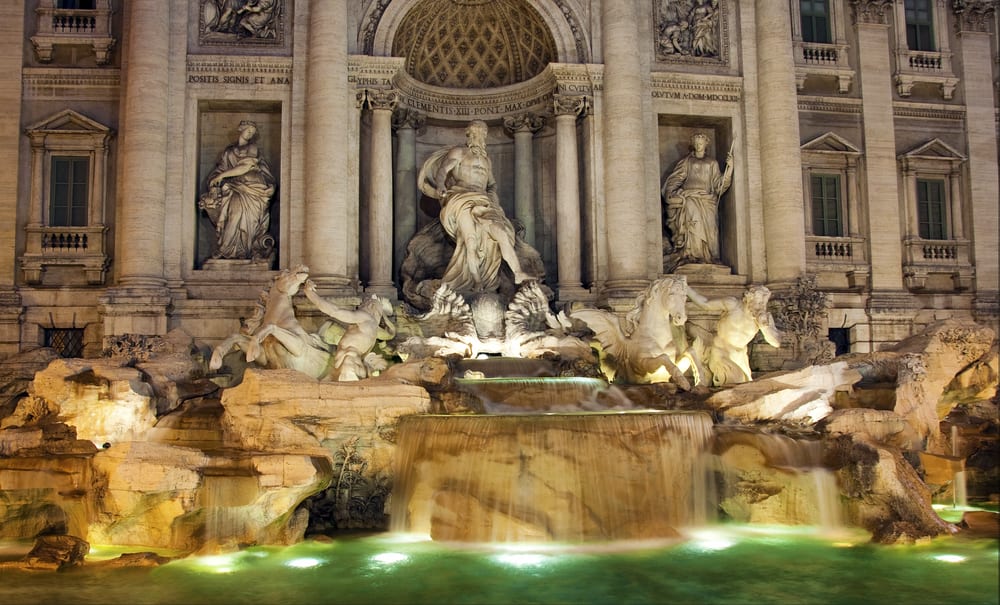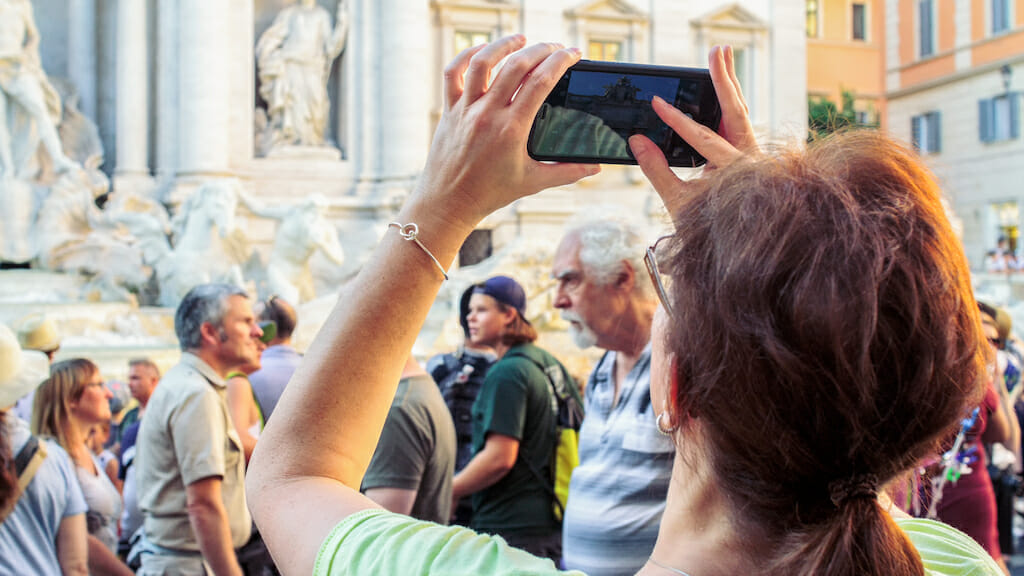
Trevi Fountain Facts: 9 Things You Didn’t Know About the Iconic Fountain
December 23, 2024
No trip to Rome is complete without a visit to the Fontana di Trevi, or Trevi Fountain. Located in the Quirinale district of Rome, the Trevi Fountain is known as one of the most stunning fountains in the world. But there’s a lot more than just beauty behind this famous fountain – keep reading to learn nine fascinating Trevi Fountain facts!

The fountain features Neptune, god of the sea on a shell-shaped chariot pulled by two horses, each being guided by a Triton. One horse is calm while the other is unruly, representing the different moods of the sea.
Though it was one of 1,352 fountains in 4th century Rome, the Trevi Fountain has always stood out from the rest. After a prolonged closure while it was being refurbished by the fashion house, Fendi (who reportedly spent a cool $2.2 million), the fountain was unveiled again – and better than ever.
Whether you’re still dreaming about visiting this landmark – or have tossed coins in the fountain numerous times – here are 9 facts you might not have known about Rome’s Trevi Fountain.
Table of Contents
ToggleFacts About the Trevi Fountain
The Trevi Fountain is one of the oldest water sources in Rome
The fountain dates back to ancient Roman times, since the construction of the Aqua Virgo Aqueduct in 19 B.C. that provided water to the Roman baths and the fountains of central Rome. It’s said that the Aqua Virgo, or Virgin Waters, is named in honor of a young Roman girl who led thirsty soldiers to the source of the spring to drink.
The fountain was built at the end point of the aqueduct, at the junction of three roads. These three streets (tre vie) give the Trevi Fountain its name, the Three Street Fountain.
Salvi was not the original architect
In 1730 Pope Clemens XII held a contest to design a new fountain. Many important architects participated, but in the end Nicola Salvi won the rights to design the fountain, though some theories say he may not have been the first choice. Alessandro Galilei, a architect from the same family as the famous astronomer Galileo, originally won the commission for the project but the commission was ultimately given to Salvi after a public outcry. The reason for the public’s objections? Galilei was a Florentine, while Salvi was a native Roman.
However Salvi never saw his fountain completed. The first water came out of the fountain in 1743 but it wasn’t until 1762 that a different Pope, Clemens XIII, officially completed and inaugurated the new Trevi Fountain, 11 years after Salvi’s death. Still, the final product is largely his.

The wonderful history if Trevi fountain will enrich your visit to this magical place.
You can thank gambling for the fountain’s existence
Salvi’s project for the fountain was the least expensive as well, a possible deciding factor for Pope Clement. In any case, the pope approved the financing of the works and used the third extraction of the lotto game to pay for it. That’s right, the money earned from the reintroduction of the lotto in Rome financed the Trevi Fountain! The numbers of the first extraction were 56, 11, 54, 18 and 6, in case you were interested.
It’s made from the same material as the Colosseum
The fountain is mostly built from travertine stone, a name that means “from the Tiber” in Latin. A mineral made of calcium carbonate formed from spring waters, especially hot springs, the likely source was the city of Tivoli, about 22 miles from Rome. During construction, many men were injured and a few died when working with enormous stone – including a stonecutter who was crushed by a large block of travertine in 1734.
The Trevi Fountain uses a lot of water
The Trevi Fountain stands a massive 85 feet tall and is almost 65 feet wide. With water pumping out of multiple sources and the large pool in front, the fountain spills about 2,824,800 cubic feet of water every day! No need to fret though, today the water is recycled. This means that, unlike the ancient Romans, you’ll have to drink from the nearby drinking fountains instead!

We recommend swinging by the Trevi Fountain at dusk or after dark for a different kind of look at the fountain.
It’s a crime to steal the coins from the Trevi
Perhaps for just that reason, it’s illegal to fish out coins from the fountain. In the past it was common for gangs of thieves to sweep the coins out of the fountain at night. In fact, three were caught by a T.V. show using a hidden camera in 2011. The most famous raider, Roberto Cercelletta, was known by his nickname, d’Artagnan. He stole the coins from the fountain for 34 years before he was caught in the summer of 2002.
The fountain is charitable
When the fountain is open roughly €3,000 is thrown into it every day as people follow the tradition of throwing coins over their shoulders. The legend holds that a coin thrown into the fountain will ensure a return to Rome. This tradition also dates back to the ancient Romans who often threw coins in water to make the gods of water favor their journey or help them get back home safely. Throw in a second coin if you’re seeking love – or even a third for wedding bells!
What many don’t know is that the coins are collected every night and given to an Italian charity called Caritas. Caritas, in turn, use the money for a supermarket program giving rechargeable cards to Rome’s needy to help them get groceries.

It’s hard to resist taking a photo of the impressive fountain.
The white stone fountain has been black…and red
In 1996 the fountain was turned off and draped in black crepe to honor actor Marcello Mastroianni after his death. Mastroianni starred in La Dolce Vita, a movie whose most famous scene was filmed in the Trevi Fountain, making the fountain more famous than ever.
In 2007 the fountain wore a different color after a vandal dumped a liquid substance into the fountain turning the water red. This caused water that fell from the fountain to be red as well, since it uses a closed circuit water system. While there was a fear that the liquid would have permanently damaged the monument, the water was drained fast enough that there was no damage, only a crowd of very surprised tourists.
The fountain has been featured in many famous films
A famed sight for tourists from throughout the world, the Trevi Fountain is quite the stage prop as well! Besides La Dolce Vita, when Anita Ekberg jumped into the Trevi Fountain with her clothes on, the massive monument has been featured in many films including Roman Holiday, Three Coins in the Fountain and even The Lizzie McGuire Movie. The fountain is even replicated at Epcot in Walt Disney World!
Update notice: This article was updated on July 17, 2023.
Want to learn more about the Trevi Fountain? Join our Rome in a Day Tour to experience the Fountain, Spanish Steps, and other Roman gems in a new light, with more fascinating facts and anecdotes from our expert guides!

by Gina Mussio
View more by Gina ›Book a Tour

Pristine Sistine - The Chapel at its Best
€89
1794 reviews

Premium Colosseum Tour with Roman Forum Palatine Hill
€56
850 reviews

Pasta-Making Class: Cook, Dine Drink Wine with a Local Chef
€64
121 reviews

Crypts, Bones Catacombs: Underground Tour of Rome
€69
401 reviews

VIP Doge's Palace Secret Passages Tour
€79
18 reviews

Legendary Venice: St. Mark's Basilica, Terrace Doge's Palace
€69
286 reviews

















